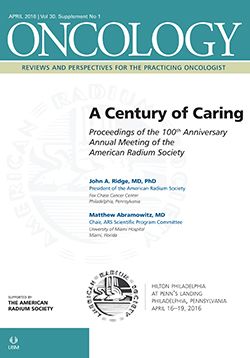(S010) Computed Tomography–Assessed Measures of Bone Mineral Density and Muscle Mass as Predictors of Survival in Men With Prostate Cancer
L5HU and psoas L4–L5, surrogates for bone mineral density and muscle mass, respectively, were independent predictors of overall survival in a multivariable model controlling for age, comorbidity, prostate cancer risk grouping, race, and ADT.
Andrew M. McDonald, MD, Thomas A. Swain, BS, David L. Mayhew, MD, PhD, Rex A. Cardan, Christopher B. Bakder, BS, David M. Harris, BS, John B. Fiveash; University of Alabama at Birmingham; Tufts University
BACKGROUND: Death in men with localized prostate cancer tends to be due to competing risks, and measures of health, such as the Charlson Comorbidity Index (CCI), have been validated as predictors of survival. We investigated if CT-assessed metrics of bone mineral density (BMD) and muscle mass yielded additional prognostic information.
MATERIALS AND METHODS: Demographic, disease, and treatment characteristics were abstracted from each patient’s chart, and age-adjusted CCI at the time of treatment was calculated. On a single axial CT slice at the mid-L5 level, the average CT attenuation of the trabecular bone of the vertebral body (L5HU) was measured using a custom script within Varian Eclipse software. The cross-sectional area of the bilateral psoas muscles (psoas L4–L5) was measured on a single CT slice at the L4–L5 vertebral interface. Cox proportional hazards models were used to assess the effects on overall survival. Using the parameter estimates from an adjusted multivariable model, a new prognostic index was generated and compared with age-adjusted CCI using Harrell’s c-index.
RESULTS: Clinical data and CT scans were available for 652 patients. Prostate cancer risk grouping, use of androgen deprivation therapy (ADT), race, age-adjusted CCI, L5HU, and psoas L4–L5 were included in a multivariable model. Increased age-adjusted CCI (hazard ratio [HR], 1.3 [95% CI, 1.19–1.43]), L5HU (HR, 2.38 [95% CI, 1.43–3.97 for L5HU < 105]; HR, 1.23 [95% CI, 0.83–1.81 for 105 ≤ L5HU ≤ 150]), and psoas L4–L5 (HR, 2.01 [95% CI, 1.38–2.94 for psoas L4–L5 < 7.5 cm2/m2]) were independent predictors of the hazard of death. The new prognostic index generated from these three variables yielded c = 0.73 vs c = 0.69 for age-adjusted CCI alone.
CONCLUSION: L5HU and psoas L4–L5, surrogates for BMD and muscle mass, respectively, were independent predictors of overall survival in a multivariable model controlling for age, comorbidity, prostate cancer risk grouping, race, and ADT. The new prognostic index was associated with improved accuracy for predicting death and may be useful for patient stratification in future randomized trials.
Proceedings of the 98th Annual Meeting of the American Radium Society - americanradiumsociety.org
